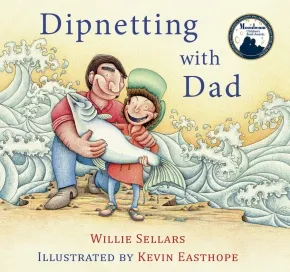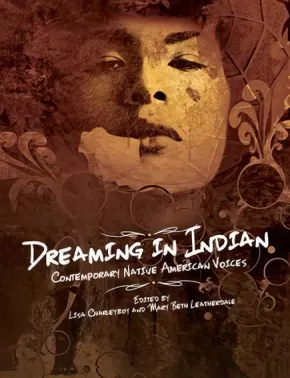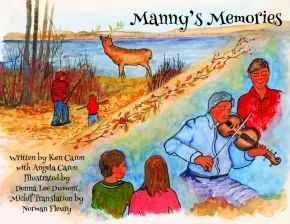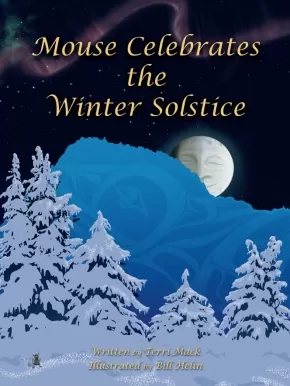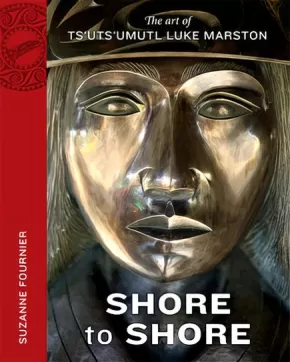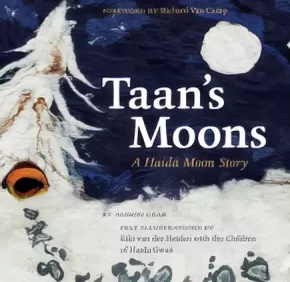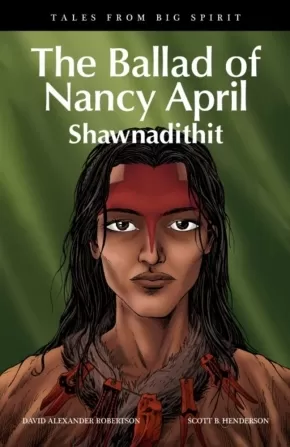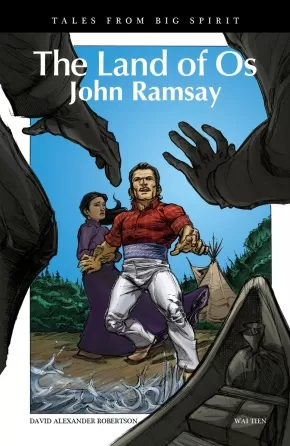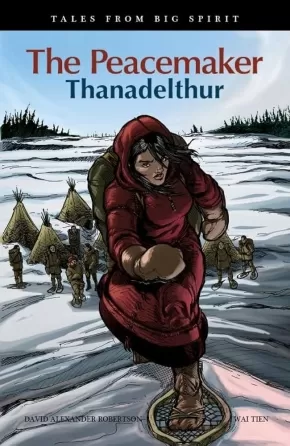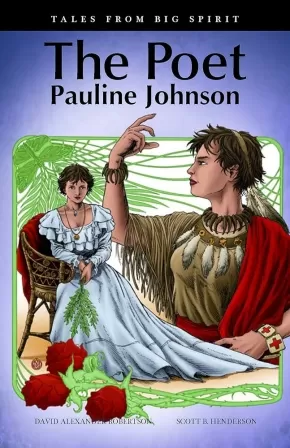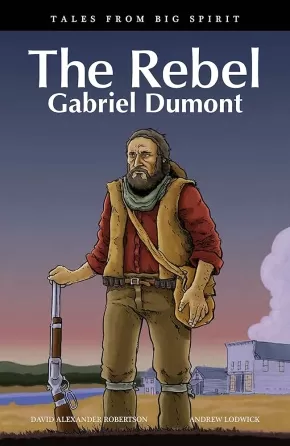
Canadian Indigenous Resource Lists
316
-
330
of
473 Results;
Sort By
Go To
of 32
Dipnetting with Dad
$19.95
Artists:
Format:
Hardcover
Text Content Territories:
Indigenous Canadian; First Nations; Salish; Interior Salish; Secwepemc (Shuswap);
ISBN / Barcode: 9781927575536
Synopsis:
Synopsis:
BUMP, BUMP - SLAP, river sockeye salmon are pulled onto shore!
Set in the beautiful landscape of the Cariboo Chilcotin region, DIPNETTING WITH DAD is a delightful and colourful story of a father teaching his son the Secwepemc method of fishing known as dipnetting. Together they visit the sweat lodge, mend the nets, select the best fishing spot and catch and pack their fish through rugged bush back to the family home for traditional preparation. In his first book, Williams Lake Indian Band member Willie Sellars captures family values, the importance of storytelling, community living and coming of age in one of BC's oldest cultures. Debut artist Kevin Easthope's contemporary and dynamic illustrations bring the characters to life as they jump off the page and pull you into their world.
Additional Information
48 pages | 9.84" x 8.58"
Dreaming in Indian: Contemporary Native American Voices
$19.95
Artists:
Editors:
Format:
Hardcover
Text Content Territories:
Indigenous American; Indigenous Canadian;
ISBN / Barcode: 9781554516872
Synopsis:
Synopsis:
A powerful and visually stunning anthology from some of the most groundbreaking Native artists working in North America today.
Truly universal in its themes, Dreaming In Indian will shatter commonly held stereotypes and challenge readers to rethink their own place in the world. Divided into four sections, ‘Roots,’ ‘Battles,’ ‘Medicines,’ and ‘Dreamcatchers,’ this book offers readers a unique insight into a community often misunderstood and misrepresented by the mainstream media.
Emerging and established Native artists, including acclaimed author Joseph Boyden, renowned visual artist Bunky Echo Hawk, and stand-up comedian Ryan McMahon, contribute thoughtful and heartfelt pieces on their experiences growing up Indigenous, expressing them through such mediums as art, food, the written word, sport, dance, and fashion. Renowned chef Aaron Bear Robe, for example, explains how he introduces restaurant customers to his culture by reinventing traditional dishes. And in a dramatic photo spread, model Ashley Callingbull and photographer Thosh Collins reappropriate the trend of wearing ‘Native’ clothing.
Whether addressing the effects of residential schools, calling out bullies through personal manifestos, or simply citing hopes for the future, Dreaming In Indian refuses to shy away from difficult topics. Insightful, thought-provoking, and beautifully honest, this book will to appeal to young adult readers. An innovative and captivating design enhances each contribution and makes for a truly unique reading experience.
Reviews
“It’s hard to imagine a middle- or high-school classroom that wouldn’t benefit from having this.” —Booklist, 02/15
“Belongs in every middle school, high school and public library.” —CM Reviews, 05/22/15
"For some time now, I've been waiting for Dreaming in Indian: Contemporary Native American Voices... It was getting buzz in Native networks on social media. I've read it, now, and highly recommend it... Dreaming in Indian has a vibrancy I've not seen in anything else. A vibrancy that, perhaps, is characteristic of a generation at ease with technology and its tools... I want to pore over the art, studying it, thinking about it, marveling at it. I can imagine a lot of people dismissing this work because it doesn't conform to their stereotypical ideas of dead or stoic Indians. But I can also imagine a lot of others holding it dear because it reflects who we are... You'll also have a solid introduction to the artists and writers, their lives, what drives them... Gritty and real, their live stories are inspiring... There's a lot to ponder in Dreaming In Indian. It'll challenge readers, in good ways, and that is a good thing. Check it out." — Debbie Reese, American Indians in Children's Literature, September 2014
Educator Information
Recommended Ages: 11-18
Themes: First Nations; native peoples; Indigenous; biography; multicultural; stereotyping; acceptance; community; prejudice; self-esteem; tolerance.
Fountas & Pinnell Reading Level: Z+
Authentic First Peoples resource K-9.
Recommended English First Peoples resource.
Additional Information
128 pages | 8.50" x 11.00" | full-color illustrations and photographs throughout, foreword, introduction
I Was Born Precious and Sacred
$12.00
Artists:
Format:
Paperback
Text Content Territories:
Indigenous Canadian;
ISBN / Barcode: 9780992151621
Synopsis:
Synopsis:
"...and this I need to know." With this refrain, Indigenous children are invited to re-learn their ancestral teachings about the Little People in their communities. With simple language and natural photographs, I Was Born Precious and Sacred acknowledges culturally integral concepts that promote the sacredness of life, the building of positive self-esteem, and an awareness of children's rights to be safe, loved and respected. Readers and listeners of all ages will be reminded that every aspect of a child is sacred and valuable and that each of us must work to preserve and nurture their minds, bodies, spirits and hearts.
Educator & Series Information
This is the first book in the Precious and Sacred series.
Reading level: K-3.
Additional Information
32 pages | 8.00" x 8.00"
Authenticity Note: This book has received the Authentic Indigenous Text label because it was written by Debora Abood with the support and participation of Elders from the Victoria Native Friendship Centre.
Lightfinder (3 in stock, in reprint)
$22.00
Artists:
Format:
Paperback
Text Content Territories:
Indigenous Canadian; First Nations; Cree (Nehiyawak);
ISBN / Barcode: 9780986874079
Synopsis:
Synopsis:
Lightfinder is a Young Adult fantasy novel about Aisling, a young Cree woman who sets out into the wilderness with her Kokum (grandmother), Aunty and two young men she barely knows.
They have to find and rescue her runaway younger brother, Eric. Along the way she learns that the legends of her people might be real and that she has a growing power of her own. The story follows the paths of Aisling and Eric, siblings unwittingly thrust into a millennia-old struggle for the future of life on earth. It deals with growing up, love and loss, and the choices life puts in our path. Love and confusion are in store, as are loss and pain. Things are not always what they seem and danger surrounds them at every turn. Will Raven's mysterious purposes prevail? With darkness closing in how will they find the light to guide them? Will Aisling find Eric in time?
Set in the Alberta landscape with references to real-world challenges faced by youth today, Lightfinder has proven to be a hit with young adults and adults alike. Lightfinder spent over 60 days in Amazon's Top 100 Sci-Fi and Fantasy novels in 2014.
Awards
- Winner of the 2015 Burt Award for First Nations, Métis and Inuit Literature!
Reviews
"With an artist's eye and a storyteller's soaring imagination, Aaron Paquette has written a page-turner. I found myself rooting hard for Aisling, Eric and their beloved Kokum. This book is a hugely engaging cautionary tale: the stakes are high if we keep giving in to our appetites. But there is great light in Lightfinder. Congratulations, Aaron, on this strong debut." - Shelagh Rogers
Educator Information
Recommended Ages: 11-18
Additional Information
240 pages | 6.00" x 9.00"
Manny's Memories
$17.50
Artists:
Format:
Paperback
Text Content Territories:
Indigenous Canadian; Métis;
ISBN / Barcode: 9781926795164
Synopsis:
Synopsis:
Manny's Memories, by Author Ken Caron with his daughter Angela Caron, introduces us to the Métis community of Round Prairie, Saskatchewan through the eyes of a young boy growing up in the 1940s. Manny shares his boyhood memories of the once vibrant community not too far from Saskatoon's city limits. Though rural life at the time called for hard work, self-sufficiency, and generosity, there was always time to have fun and to enjoy being a young Métis boy. Artist Donna Lee Dumont's visual expression of Manny's Memories helps us see the world as Ken, called "Manny" in his youth, remembers it. Norman Fleury's accompanying Michif translation and narration returns to the language which Manny often hears as a boy. Manny's Memories leaves us with a rare and satisfying glimpse of life not so long ago.
Educator Information
Grade Level: Primary
Format: Book/CD, English/Michif-Cree
Additional Information
36 pages | 10.94" x 8.46"
Mouse Celebrates the Winter Solstice
 $16.50
$16.50

Artists:
Format:
Paperback
Text Content Territories:
Indigenous Canadian; First Nations; Kwakwaka'wakw (Kwakiutl);
ISBN / Barcode: 9781771740555
Synopsis:
Synopsis:
It is winter. The land lies still, quiet and stark beneath a blanket of snow. The tiny footprints of a mouse can be seen in the light of the moon.
"Wrapped in the quiet, and there in the bleak, there stood a wise mouse, preparing to speak."
The words that mouse chose were from many years past. She spoke them into the cold night air. So begins the enchanting story of a very special Winter Solstice celebration.
Kwakwaka’wakw author Terri Mack and Tsimshian artist Bill Helin have collaborated to bring us this story of strength, friendship and celebration. The lyrical text and engaging illustrations will appeal to readers of all ages.
Author's note:
Gila'kasla!
I spent a year writing and rewriting this poem to be sure to convey the message clearly to my audience. It was important to me that the poem reflect the importance of us all joining together to find the sacredness in celebration, the joy of belonging within a greater community and the voice of determination inside of each of us. Inspired by Indigenous Peoples rising, healing and joining together I hope that this poem inspires our youth to be strong and determined in all their future goals.
~Terri Mack
Additional Information
24 pages | 9" x 12" | ISBN: 9781771740555 | Paperback
Not My Girl
$9.95
Artists:
Format:
Paperback
Text Content Territories:
Indigenous Canadian; Inuit; Inuvialuit (Mackenzie Inuit);
ISBN / Barcode: 9781554516247
Synopsis:
"Culturally relevant, accurate, and soft, painterly illustrations depict the sequence of events and reinforce the bittersweet and tender reunion of Olemaun with her family."— Natalie Braham, School Library Journal, September 2014
Synopsis:
Margaret can't wait to see her family, but her homecoming is not what she expected.
Two years ago, Margaret left her Arctic home for the outsiders' school. Now she has returned and can barely contain her excitement as she rushes towards her waiting family -- but her mother stands still as a stone. This strange, skinny child, with her hair cropped short, can't be her daughter. "Not my girl!" she says angrily.
Margaret's years at school have changed her. Now ten years old, she has forgotten her language and the skills to hunt and fish. She can't even stomach her mother's food. Her only comfort is in the books she learned to read at school.
Gradually, Margaret relearns the words and ways of her people. With time, she earns her father's trust enough to be given a dogsled of her own. As her family watches with pride, Margaret knows she has found her place once more.
Based on the true story of Margaret Pokiak-Fenton, and complemented by evocative illustrations, Not My Girl makes the original, award-winning memoir, A Stranger at Home, accessible to younger children. It is also a sequel to the picture book When I Was Eight. A poignant story of a determined young girl's struggle to belong, it will both move and inspire readers everywhere.
Reviews
"For kids who are ready to tackle the not so sunny portion of history, this is a deeply felt exploration of identity and cultural crisis rendered as a deep, satisfying sigh appropriate for sharing aloud." — BCCB The Bulletin of the Center for Children's Boo, August 2014
"Culturally relevant, accurate, and soft, painterly illustrations depict the sequence of events and reinforce the bittersweet and tender reunion of Olemaun with her family."— Natalie Braham, School Library Journal, September 2014
Educator Information
Recommended for ages 6 to 9.
This book is available in French: Ou est ma fille?
Additional Information
36 pages | 9.00" x 9.00"
Peace Pipe Dreams
$22.95
Format:
Paperback
Text Content Territories:
Indigenous Canadian; Métis; Inuit; First Nations;
ISBN / Barcode: 9781771000406
Synopsis:
Synopsis:
In 2015-2016, Peace Pipe Dreams was the award recipient for First Nation Communities Read.
Darrell Dennis is a stereotype-busting, politically incorrect Native American/Aboriginal/Shuswap (Only he's allowed to call himself an "Indian." Maybe. Under some circumstances). With a large dose of humour and irreverence, he untangles some of the truths and myths about First Nations: Why do people think Natives get free trucks, and why didn't he ever get one? Why does the length of your hair determine whether you’re good or bad? By what ratio does the amount of rain in a year depend on the amount of cactus liquor you consume?
In addition to answering these burning questions, Dennis tackles some tougher subjects. He looks at European-Native interactions in North America from the moment of first contact, discussing the fur trade, treaty-signing and the implementation of residential schools. Addressing misconceptions still widely believed today, Dennis explains why Native people aren't genetically any more predisposed to become alcoholics than Caucasians; that Native religion doesn't consist of worshipping rocks, disappearing into thin air, or conversing with animals; and that tax exemptions are so limited and confusing that many people don't even bother.
Employing pop culture examples, personal anecdote and a cutting wit, Darrell Dennis deftly weaves history with current events to entertain, inform and provide a convincing, readable overview of First Nations issues and why they matter today.
Additional Information
224 pages | 5.65" x 8.52"
Shore to Shore: The Art of Ts'uts'umutl Luke Marston
$26.95
Format:
Paperback
Text Content Territories:
Indigenous Canadian; First Nations; Salish; Coast Salish;
ISBN / Barcode: 9781550176704
Synopsis:
Synopsis:
Stanley Park, Vancouver, September 2014. A fourteen-foot bronze-cast cedar sculpture is being erected. Dignitaries from all levels of government are present, including leaders of the Coast Salish First Nations and representatives from Portugal's Azores Islands. Luke Marston, carver/artist, supervises as his three-year project is revealed to the world.
The sculpture--titled Shore to Shore--depicts Luke's great-great-grandparents, Portuguese Joe Silvey, one of BC's most colourful pioneers, and Kwatleematt (Lucy), a Sechelt First Nation matriarch and Silvey's second wife. Silvey and Kwatleematt are flanked by Khaltinaht, Silvey's first wife, a noblewoman from the Musqueam and Squamish First Nations. The trio are surrounded by the tools of Silvey's trade: seine nets, whaling harpoons, and the Pacific coast salmon that helped the family thrive in the early industries of BC. The sculpture references the multicultural relationships that are at the foundation of BC, while also showcasing the talents of one of Canada's finest contemporary First Nations carvers.
Combining interviews, research and creative non-fiction narration, author Suzanne Fournier recounts Marston's career, from his early beginnings carving totems for the public at the Royal BC Museum, to his study under Haida artist Robert Davidson and jewellery master Valentin Yotkov, to his visits to both his ancestral homes: Reid Island and the Portuguese Azores island of Pico--journeys which provided inspiration for the Shore to Shore statue.
Educator Information
Recommended in the Canadian Indigenous Books for Schools 2015/2016 resource list for grades 7 to 12 for comparative civilizations, English language arts, photography, social studies, and visual arts.
Additional Information
128 pages | 8.00" x 10.00"
Taan's Moons: A Haida Moon Story
$19.99
Artists:
Format:
Hardcover
Text Content Territories:
Indigenous Canadian; First Nations; Haida;
ISBN / Barcode: 9780991678242
Synopsis:
Synopsis:
“There’s a moon in the sky. It looks like a drum, which guides the earth where Taan is from.”
So begins a year in the life of Taan, which means “bear” in the Haida Language.
Alison Gear has based this wonderfully engaging and thoughtful story on one version of the Haida Moon cycle. It follows Taan as she experiences the wonder of the unfolding seasons.
Kiki van der Heiden worked closely with the children on Haida Gwaii to create the absolutely stunning felted artwork that gracefully complements each page of Taan’s story.
This is a story woven together by the community on Haida Gwaii.
Alison and Kiki worked closely with elders, teachers, children, parents, and caregivers to produce this unforgettable book. The title of each moon cycle has been translated into both Skidegate and Old Massett Haida, honouring language and wisdom. The children involved in this project, under Kiki’s gentle guidance, were hands-on each rendering of the felt pieces until they became the sculpted illustrations currently featured in Taan’s Moons.
When award-winning, best-selling author Richard Van Camp visited Haida Gwaii, he had the opportunity to read the manuscript for Taan’s Moons. He graciously agreed to contribute the heartfelt Foreword, which begins:
“Welcome to Taan’s Moons, one of the most beautiful books I have ever witnessed.”
We agree, Richard. We certainly agree.
We also want to give sincere thanks to Joanne Yovanovich, Tawni Davidson, Beng Favreau, and ArtStarts in Schools for their contribution to and support of this important book.
Authenticity Note: This book has been given the Authentic Indigenous Text label because of the collaboration of Indigenous peoples to create it. It is up to readers to determine if it is authentic for their purposes.
The Ballad of Nancy April: Shawnadithit
$17.95
Artists:
Format:
Paperback
Text Content Territories:
Indigenous Canadian; First Nations; Beothuk;
ISBN / Barcode: 9781553794776
Synopsis:
Synopsis:
When a mishap delays Jessie at the end of a school day, she takes a shortcut home. But the shortcut turns into an adventure, as Jessie is transported through time and space, to early 19th-century Newfoundland. There she meets Shawnadithit who, as the last surviving member of the Beothuk, has witnessed the end of a once-great people.
Educator & Series Information
Tales from Big Spirit is a unique graphic novel series that delves into the stories of great Indigenous heroes from Canadian history—some already well known and others who deserve to be. Designed to correspond to grades 4–6 social studies curriculums across Canada, these full colour graphic novels could be used in literature circles, novel studies, and book clubs to facilitate discussion of social studies topics. These books will help students make historical connections while promoting important literacy skills.
Grades 4-6
A Teacher's Guide is also available for the Tales from the Big Spirit Series: Tales from the Big Spirit Series Teacher's Guide
The teacher's guide is designed to help classroom teachers use the graphic novel series, Tales From Big Spirit, by David Alexander Robertson. The guide provides detailed lessons that meet a wide range of language arts and social studies goals, integrate Indigenous perspectives, and make curricular content more accessible to diverse learners.
This resource is also available in French: D'hier à aujourd'hui, L’héritage de Nancy April : Shawnadithit
Additional Information
30 pages | 6.50" x 10.00"
The Land of Os: John Ramsay
$17.95
Artists:
● Wai Tien
Format:
Paperback
Text Content Territories:
Indigenous Canadian; First Nations; Anishinaabeg; Ojibway; Saulteaux;
ISBN / Barcode: 9781553794912
Synopsis:
Synopsis:
When Richard’s class from Big Spirit School takes a canoe trip, he and his classmates chance upon an elderly woman. She tells them the story of her grandfather, John Ramsay, of the Sandy Bar community on Lake Winnipeg. Ramsay’s land was taken by the government and given to the new settlers from Iceland who arrived there in 1875. Yet many owed their survival to Ramsay, who helped them through freezing winters, hunger, and a devastating smallpox epidemic.
Educator & Series Information
The Land of Os is one book in the Tales From Big Spirit series. Tales from Big Spirit is a unique graphic novel series that delves into the stories of great Indigenous heroes from Canadian history—some already well known and others who deserve to be. Designed to correspond to grades 4–6 social studies curriculums across Canada, these full colour graphic novels could be used in literature circles, novel studies, and book clubs to facilitate discussion of social studies topics. These books will help students make historical connections while promoting important literacy skills.
A Teacher's Guide is also available for the Tales from the Big Spirit Series: Tales from the Big Spirit Series Teacher's Guide. The teacher's guide is designed to help classroom teachers use the graphic novel series, Tales From Big Spirit, by David Alexander Robertson. The guide provides detailed lessons that meet a wide range of language arts and social studies goals, integrate Indigenous perspectives, and make curricular content more accessible to diverse learners.
This resources is also available in French: D'hier à aujourd'hui, Le protecteur d’Ós : John Ramsay
Additional Information
30 pages | 6.50" x 10.00"
The Peacemaker: Thanadelthur
$17.95
Format:
Paperback
Text Content Territories:
Indigenous Canadian; First Nations; Dene; Denesuline (Chipewyan);
ISBN / Barcode: 9781553794790
Synopsis:
Synopsis:
When Cole's teacher catches him drawing rather than listening in class, he gives Cole a special assignment: an oral presentation on an important Aboriginal figure. Cole will do almost anything to avoid speaking in public -- even feigning illness. But when he hear the story of the remarkable woman known as Thanadelthur -- peacemaker between the Cree and the Dene and interpreter for the governor of Fort York -- he is so inspired by her bravery, he overcomes his own fears.
Educator & Series Information
Tales from Big Spirit is a unique graphic novel series that delves into the stories of great Indigenous heroes from Canadian history—some already well known and others who deserve to be. Designed to correspond to grades 4–6 social studies curriculums across Canada, these full colour graphic novels could be used in literature circles, novel studies, and book clubs to facilitate discussion of social studies topics. These books will help students make historical connections while promoting important literacy skills.
Grades 4-6
Tales from the Big Spirit Series Teacher's Guide - Tales from the Big Spirit Series Teacher's Guide
The teacher's guide is designed to help classroom teacher's use the graphic novel series, Tales From Big Spirit, by David Alexander Robertson. The guide provides detailed lessons that meet a wide range of language arts and social studies goals, integrate Indigenous perspectives, and make curricular content more accessible to diverse learners.
The Peacemaker is available in French: L’ambassadrice de la paix : Thanadelthur
Additional Information
30 pages | 6.50" x 10.00"
The Poet: Pauline Johnson
$17.95
Artists:
Format:
Paperback
Text Content Territories:
Indigenous Canadian; First Nations; Haudenosaunee (Iroquois); Kanyen'keha:ka (Mohawk);
ISBN / Barcode: 9781553794813
Synopsis:
Synopsis:
Although Kathy loves poetry, she is far too shy to recite it in front of her class. But the story of Pauline Johnson, renowned as the "Mohawk Princess," inspires Kathy to overcome her stage fright. Pauline, from the Grand River Reserve in Ontario, crisscrossed the country, reciting her poems to far-flung communities, making her among the most beloved literary figure of the Edwardian era.
Educator & Series Information
Tales from Big Spirit is a unique graphic novel series that delves into the stories of great Indigenous heroes from Canadian history—some already well known and others who deserve to be. Designed to correspond to grades 4–6 social studies curriculums across Canada, these full colour graphic novels could be used in literature circles, novel studies, and book clubs to facilitate discussion of social studies topics. These books will help students make historical connections while promoting important literacy skills.
Grades 4-6
Tales from the Big Spirit Series Teacher's Guide - Tales from the Big Spirit Series Teacher's Guide
The teacher's guide is designed to help classroom teacher's use the graphic novel series, Tales From Big Spirit, by David Alexander Robertson. The guide provides detailed lessons that meet a wide range of language arts and social studies goals, integrate Indigenous perspectives, and make curricular content more accessible to diverse learners.
The Poet: Pauline Johnson is available in French: La poète : Pauline Johnson
Additional Information
30 pages | 6.50" x 10.00"
The Rebel: Gabriel Dumont
$17.95
Artists:
Format:
Paperback
Text Content Territories:
Indigenous Canadian; Métis;
ISBN / Barcode: 9781553794769
Synopsis:
Synopsis:
For Tyrese, history class is the lowest point of his school day. That is, until his friend Levi reveals a secret – a secret that brings history alive, in the form of one Gabriel Dumont. Through Dumont, a great Métis leader of the Northwest Resistance, the boys experience a bison hunt, a skirmish with the Blackfoot, and an encounter with the great Louis Riel, and, ultimately, a great battle of the Northwest Resistance at Batoche, Saskatchewan.
Educator & Series Information
The Rebel is one book in the Tales from Big Spirit series. Tales from Big Spirit is a unique graphic novel series that delves into the stories of great Indigenous heroes from Canadian history—some already well known and others who deserve to be. Designed to correspond to grades 4–6 social studies curriculums across Canada, these full colour graphic novels could be used in literature circles, novel studies, and book clubs to facilitate discussion of social studies topics. These books will help students make historical connections while promoting important literacy skills.
Grade: for grades 4–6
A Teacher's Guide is also available for the Tales from the Big Spirit Series: Tales from the Big Spirit Series Teacher's Guide. The teacher's guide is designed to help classroom teachers use the graphic novel series, Tales From Big Spirit, by David Alexander Robertson. The guide provides detailed lessons that meet a wide range of language arts and social studies goals, integrate Indigenous perspectives, and make curricular content more accessible to diverse learners.
This resources is also available in French: D'hier à aujourd'hui, Le rebelle : Gabriel Dumont
Additional Information
30 pages | 6.50" x 10.00"
Sort By
Go To
of 32

